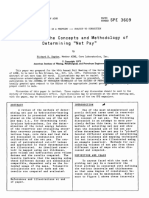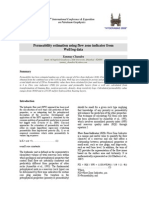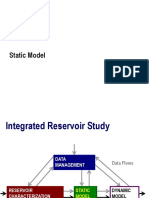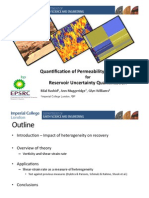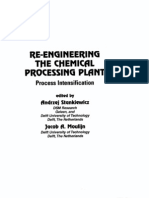Hfu and Fzi
Hfu and Fzi
Uploaded by
Anre Thanh HungCopyright:
Available Formats
Hfu and Fzi
Hfu and Fzi
Uploaded by
Anre Thanh HungOriginal Title
Copyright
Available Formats
Share this document
Did you find this document useful?
Is this content inappropriate?
Copyright:
Available Formats
Hfu and Fzi
Hfu and Fzi
Uploaded by
Anre Thanh HungCopyright:
Available Formats
SPE-169307-MS
Hydraulic Unit Determination and Permeability Prediction Based On Flow
Zone Indicator Using Cluster Analysis
Cesar Aguilar and Hugo Govea, Petrleos de Venezuela E&P (PDVSA); Guillermo Rincn, (Paradigm)
Copyright 2014, Society of Petroleum Engineers
This paper was prepared for presentation at the SPE Latin American and Caribbean Petroleum Engineering Conference held in Maracaibo, Venezuela, 2123 May
2014.
This paper was selected for presentation by an SPE program committee following review of information contained in an abstract submitted by the author(s). Contents
of the paper have not been reviewed by the Society of Petroleum Engineers and are subject to correction by the author(s). The material does not necessarily reflect
any position of the Society of Petroleum Engineers, its officers, or members. Electronic reproduction, distribution, or storage of any part of this paper without the written
consent of the Society of Petroleum Engineers is prohibited. Permission to reproduce in print is restricted to an abstract of not more than 300 words; illustrations may
not be copied. The abstract must contain conspicuous acknowledgment of SPE copyright.
Abstract
Classical discrimination of petrophysical rock types is based on subjective geological observations and on
empirical relationships between permeability and porosity data. The Hydraulic Unit approach is a
methodology for classification of rock types and prediction of flow properties, based on flow zone
indicator that incorporates geological attributes of texture, mineralogy and the physics of flow at pore
scale to discriminate distinctive hydraulic units.
This paper presents a methodology for the determination of Hydraulics Units and permeability
prediction using a cluster analysis technique due to a hydraulic units zonation process requires a rigorous
statistical approach. MULTI-RESOLUTION-GRAPH-BASED CLUSTERING (MRGC) is a very powerful non-parametric algorithm which allows defining the optimal number of hydraulic units.
The methodology was applied to Venezuelan Eocene sandstone reservoir integrating core data (flow
zone indicator) and log data such as porosity, shale volume and caliper as an input data. Compared to
previously classification, based on lithofacies information, it yielded to increased accuracy of permeability
prediction and enhance reservoir description. All geological information available was integrated (core
descriptions, image log, lithofacies, XRD, thin sections and SEM information) and five hydraulic units
were identified, without any a priori subjective knowledge. A detailed characterization was achieved,
determining rock properties (porosity and permeability) and SCAL properties (capillary pressure and
relative permeability curves) by each rock type, which is an input data in the dynamic modeling of the
reservoir.
In order to verify this approach a nodal analysis was performed in an uncored well using all data
available (buildup-flowing bottom hole, RFT-pressure data, petrophysical and fluid reservoir properties)
obtaining and excellent match between real and predicted initial oil production.
Introduction
Reservoir rock classification has become a fundamental part of reservoir modeling. Accurate determination of pore-body/throat attributes and fluid distribution are central elements in improved reservoir
description. Amaefule7 initialized the concept of hydraulic flow unit based on a modified Kozeny-Carman
equation, and he used the flow zone indicator (FZI) to characterize different reservoir rocks. He defined
SPE-169307-MS
Figure 1Location of the reservoir under study
Figure 2Best Predictor Logs Using Cross Validation
Figure 3Hydraulics Units identified using MRGC Algorithm
hydraulic unit as volume of total reservoir rock within which geological and petrophysical properties that
affect fluid flow are internally consistent and predictable different from properties of other rock volumes.
This methodology indicates that for any hydraulic unit, a log-log plot of Reservoir Quality Index (RQI)
given by equation (1) versus Normalized Porosity Index (z) given by equation (2) should yield a straight
line with a unit slope. The intercept of this with z 1, is designated as the flow zone Indicator, a unique
parameter for each hydraulic unit that incorporates geological attributes of texture and mineralogy in the
discrimination of distinct pore geometrical facies.
SPE-169307-MS
Table 1Average Petrophysical Properties for each Hydraulic Unit
Figure 4 Plot of log RQI vs. log z with the five hydraulic units identified
(1)
(2)
Hydraulic units zonation process requires a rigorous statistical approach. According to Abbaszadeh18,
simplified approaches that analyze the behavior of the logarithm FZI in a probabilistic plot are imprecise
and subjective.
A variety of approaches have been proposed for partitioning well-log responses into distinct classes in
order to improve reservoir characterization and permeability predictions. The simplest approach uses
reservoir layering. Other schemes use lithofacies information identified from core description. Rabiller10,
Cuddy9, Tiab1 stated that there is a strong nonlinear relationship between log and lithology data, which
makes it difficult to tie any log data partition to a sedimentologically relevant description. Rabiller10
pointed out that the differences among the relative distances between classes in the log space and
SPE-169307-MS
Figure 5Normalized Gamma Ray vs. Bulk Density discriminated by Hydraulics Units
Figure 6 Display of the VLE1308 Petrophysical Evaluation, showing the HU zonation and permeability prediction
SPE-169307-MS
Figure 7VLE1308 Facies Distribution following Rodriguezs Classification
Figure 8 Relationship between Lithofacies and Hydraulics Units (left corner to the
geological space is the cause for this nonlinearity and proposed a two step approach to address the
dimensionality problem, first an automatic clustering process and then a manual merge.
MULTI-RESOLUTION GRAPH-BASED CLUSTERING (MRGC) is a very powerful nonparametric
algorithm which allows to define the optimal number of hydraulic units, and includes two steps. First
based on the behavior of the underlying multivariable probabilistic density function the algorithm is able
SPE-169307-MS
Figure 9 Cross-plot of core-derived and log-derived permeability, wells VLE0720 and VLE1308
Figure 9 Cross-Section of the wells LPG1211 and VLE0339. Permeability prediction tie with core information
to recognize important structures (modes) which suggest a different class. Then the user have the
possibility to merge different clusters based on geological meaning and histograms analysis, crossplots
and the integration of all the geological information available, core descriptions, image log, lithofacies,
XRD, thin sections and SEM information. The major advantage of MRGC is that does not need any a
priori knowledge to perform the clusters analysis and offers reliability in processing very complex data
SPE-169307-MS
Figure 10 Average Capillary and Relative Permeability curves for each hydraulic unit
configurations such as varied shapes, different densities/volumes, small sizes and not well-separated
clusters.
Field Study
The reservoir under study is an Eocene shaly sandstone reservoir located at the south center of the basin
of Maracaibos lake, Venezuela (Figure 1). The sand deposits are primarily of channel-type, corresponding to a fluvial-deltaic deposition system. The field which started to produce in 1959 is a brown field and
has been subjected to water and gas injection. The main purpose of this detailed characterization is to
identify new infill drilling opportunities and bypassed oil zones in the reservoir.
There are four cored wells in the field: VLE0339, VLE0720, VLE1308 and LPG1211. The log and core
data corresponding to the wells VLE0720 and VLE1308 were used as the training data for the zonification
process, whereas the data from wells VLE0339 and LPG1211, drilled at the early 60s, were not take into
account because do not have open hole gamma ray and there are uncertainties about the quality of the core
gamma ray.
SPE-169307-MS
Figure 10 Irreducible water saturation vs. flow zone indicator (FZI)
Data Corrections
Porosity and permeability core data were both Klinkenberg and stress-corrected. The stress corrections
were made according to Jones19. On the other hand, environmental corrections were applied to all logs and
gamma ray logs were also normalized because there are many different types and ages of gamma ray in
the field. In addition, bad hole corrections were applied to the density logs.
Best-Predictor-Logs-Definition
First at all, it is necessary to choose the logs which should be used to perform cluster analysis. A cross
validation with the leave-one out method was performed using the software Geolog (Figure 2). From this
analysis, it can be concluded that effective porosity, shale volume using Stieber 2 method and caliper are
the best FZI discriminators for this study, since the associated error in the classification process is less than
7% using these input logs.
Hydraulic Unit Zonation
Based on the MRGC Algorithm, five different Hydraulic Units (HU) were identified with different
average value of input data and a very distinctive PDF, as shown in Figure 3 and Table1. HU1 and HU2
have excellent reservoir properties, HU3 has a good reservoir properties, HU4 is a very shaly sandstone
and HU5 is a non-reservoir rock.
These five hydraulic units also can be plotted in the normalized Porosity Index vs. Rock Quality Index
(RQI) plot as shown in Figure 4.
It is very important to check if the propagation of these five hydraulic units is reasonable in the uncored
intervals. A classic cross-plot between gamma ray normalized and bulk density shows that there is not any
illogical distribution of the HU. There is a consistency in the results; best hydraulic units are associated
to low gamma ray and bulk density values, which represents low shale volume and high porosity. Figure
5
All the geological information available (Core descriptions, image log, lithofacies, XRD, thin section
and SEM information) were gathered in order to observe if the results are linked. In Figure 6, tracks 1 and
3 show conventional logs (gamma ray, deep and medium resistivity curves), track 4 compares total
core-derived porosity and total log-derived porosity, track 5 shows volume of shale estimated by Stieber
SPE-169307-MS
Figure 11Production of the well VLE0621 and behavior of the reservoir pressure
2 model and XRD clay volume calibrated with thin section and SEM information, track 6 shows a
comparison between core-derived permeability and the permeability prediction using logs and flow zone
indicator theory, track 7 shows HU zonification (Yellow is the best quality and Green is the worst quality),
track 8 displays core FZI estimation data and FZI calculated using logs, tracks 9 and 10 display image log
and core lithofacies description, and tracks 11 and 12 display thin section and core photos. The results
pointed out the effectiveness of the proposed zonation process.
Based on Rodriguez14, the lithofacies on VLE1308 can be classified as shown in Figure 7; hence, a
relationship between lithofacies and Hydraulic Units can be established. A histogram of the lithofacies
presented by each hydraulic unit is shown in Figure 8 and reveals that HU1 and HU2 are the best related
to lithofacies S3/S11 medium grained sandstones. HU3 and HU4 are characterized by the increment of
very fine grained sandstones with continuous and discontinuous clay intercalations lithofacies S1/S2.
Finally, HU5 consists of heterolithic and shale lithofacies Ha/HL/L. Although, there is a relationship
10
SPE-169307-MS
Figure 12Petrophysical Evaluation of the well VLE0621. Average Absolute Permeability in the Perforated Intervals is 250 mD
between HU and lithofacies, there are certain differences because they do not necessarily coincide with
facies boundary. Besides, lithofacies do not take into account microscopic properties (e.g. tortuosity and
specific surface) as does the flow zone indicator, which results in a more detailed reservoir characterization.
Permeability prediction based on Flow Zone Indicator (FZI)
Once the HU were identified, the FZI is propagated as a continuous log parameter in the wells, and
permeability distribution is calculated according to
(3)
Figure 9 shows a crossplot between core-derived permeability and log-derived permeability, which
indicates a good correlation since the correlation coefficient is 0.80.
Although there are uncertainties about core depth shifting in the olds wells VLE0339 and LPG1211,
the predicted permeability profile reproduces the general trend exhibited by core measurements as shown
in Figure 9.
SPE-169307-MS
11
SCAL Analysis by Rock Types
SCAL properties are the key to understand the flow behavior in the porous media. Calculating average
SCAL properties using different rock types samples will yield a wrong reservoir model. Average curves
of capillary pressure and relative permeability for each hydraulic unit were determined, and the results are
given in Figure 10. Leverett J-Function (equation 4) was used for the generation of a unique capillary
pressure curve for each hydraulic unit. For the relative permeability curves, the data was normalized and
then expressed in the Corey19 form. This will provide excellent input data for the reservoir-simulation
model.
(4)
Where:
Pc Capillary pressure (psi)
Interfacial Tension (dinas/cm)
Cos Contact Angle Cosine (Grades)
Sw water saturation (fraction)
The cross-plot displayed on Figure 10 demonstrates the excellent correlation between flow zone
indicator and irreducible water saturation (from capillary pressure). As expected, Swir decreases with
increasing FZI, which is an indication of how FZI controls flow properties.
Model Validation with Production Data
The validity of the model is checked with production data through nodal analysis using Pipesim software.
Hein20 defined nodal analysis as the process by which the hydraulic effects of parameter variations are
calculated and displayed. In nodal analysis, two parameters or sets of parameters are studied at the same
time.
The pipeline is divided into two flow strings: the Inflow section and the Outflow section. The node,
from which the method derives its name, is the delimiter between the two halves. Multiphase PVT,
pressure and temperature calculations are performed in both traverses at several flow rates and sensitivity
parameter values. The calculations take place in the same direction as the flow in the Inflow section, and
in the opposite direction in the Outflow segment. The calculated node pressure is plotted for both sections
as a function of throughput, and the intersection of the Inflow and Outflow curves represent the operating
point of the system.
The well VLE0621 was chosen for this purpose, since it has build up test information, flowing pressure
data, a repeat formation tester and a common log set in the reservoir, which includes a density log with
good hole conditions.
In this nodal analysis, the calculation of the inflow curve requires effective oil permeability. This way
is possible to validate the petrophysical and fluid model of the reservoir. RFT and historic pressure
behavior show an average reservoir pressure of 3000 psi in 1972 and an initial oil production of 1820
STBOPD with 2% of water cut (Figure 11).
The effective oil permeability is calculated using the absolute permeability and the relative permeability curve in the perforated intervals. Figure 12 shows an average absolute permeability of 250 mD and
the average relative permeability corresponding to HU1 and HU2, which were obtained by petrophysical
evaluation of the well.
A sensitivity analysis was performed to find the invasion diameter of the fluid during drilling and
completion; it is difficult to determine this parameter. It was found that the length of damage damaged
zone varied from 15 to 50 inches, with a most probable value of 35 inches. Nodal analysis showed a range
12
SPE-169307-MS
Figure 13VLE0621 Nodal Analysis. Sensitivity Analysis of the Invasion Length
between 1923 STBOPD to 1863 STBOPD, with a most probable value of 1911 STBOPD. This parameter
does not have strong effect in the oil rate calculation (Figure 13)
An excellent match between the oil production rate calculated by nodal analysis and real production
was obtained. This consistency adds a lot of confidence to the subsequent OOIP estimations and to the
reservoir simulation model.
Conclusions
Based on a rigorous statistical approach (MRGC) and on the integration of all the geological
information available, it was possible to identify the optimal number of hydraulic units in the
reservoir under study.
Accurate permeability prediction is achieved by means of the flow zone indicator approach.
Flow zone indicator correlates very well with irreducible water saturation which is an indication
of how FZI controls flow properties.
Reproduction of the well performance behavior allows to validate the integration of reservoirsurface models and consequently permeability and SCAL properties obtained in this study can be
used as an input for numerical simulation purposes for this reservoir.
Acknowledgments
The authors thank PDVSA for permission granted for the publication of this manuscript. Additional
thanks to Otto Seger for his dedicated efforts in the preparation of this manuscript and to Gloria Subero
for technical editing and assistance.
References
1. Tiab D, Donaldson E. Petrophysics 2 Ed. Gulf Professional Publising (2004)
2. Pirson S. Handbook of Well Log Analysis. Prentice Hall. (1963)
SPE-169307-MS
13
3. Corelab. Fundamentals of Specials Core Analysis(1982)
4. Rider M. The Geological interpretation of Well Logs. 2 Ed.Rider-French Consulting LTD.
(2000)
5. Bird. R.B. Steware, W.E. and Lightfoot, E.N.: Transport Phenomena. New York. Wiley (1960).
6. Carmen. P.e.: Fluid Flow through Granular Beds, Trans. AIChE (1937) v. 15. 150 166.
7. Amaefule J, Altunbay M, and Tiab D, Enhanced Reservoir Description: Using Core and Log Data
to Identify Hydraulic (Flow) Units and Predict Permeability in uncored Intervals/Wells.SPE
26436 (1993)
8. Ebanks W.J.Jr.: Integrated Approach to Reservoir Description for Engineering Projects.
(abstract only) AAPGAbstract Flow Unit Concept.
9. Cuddy, S. The Application of the Mathematics of Fuzzy Logic to Petrophysics. SPWLA 38th
Annual Logging Symposium, June 1518, 1997
10. Rabiller, P and Ye, S. A New Tool for Electro-Facies Analysis: Multi-Resolution-Graph-Based
Clustering. SPWLA 41th Annual Logging Symposium, June 4 7, 2000.
11. Rabiller, P and Ye, S. The Iterative Use of Clustering and Modeling to Improve Permeability
Prediction. SPWLA 42nd Annual Logging Symposium, June 1720, 2001.
12. Leverett. M.e.: Capillary Behavior in Porous Solids, Petroleum Technology. T. P. 1223 (1940)
152169.
13. Rose, W. and Bruce. W.A.: Evaluation of Capillary Character in Petroleum Reservoir Rock,
Petroleum Transactions. AIME (1949) 127142.
14. Rodriguez, A. Facies Modeling and the Flow Unit Concept as a Sedimentological Tool in
Reservoir Description. A Case Study. SPE 18154.(1988).
15. DWindt, A. Reservoir Zonation and Permeability Estimation: A Bayesian Approach. SPWLA
48th Annual Logging Symposium, June 3 6, 2007.
16. Buchep J Some Applications of Methods Used in Electrofacies Identification. The log analyst.
January February. 1994.
17. Donnez, P. Essential of reservoir Engineering. Editions Technip. 2007.
18. Abbaszadeh, M and Fujii, H. Permeability prediction by hydraulic flow units Theory and
application. SPE Formation evalution 1996.
19. Jones, S.C. two Point determinations of permeability and PV vs. Net Confining Stress, SPE
formation evaluation, March 1988
20. Hein M. Nodal analysis as applied to pipelines and risers.SPE 8708.1987
21. Corey, A.T. Mechanics of inmiscible fluids in porous media. Colorado: Water Resources
Publications.
You might also like
- Civil Examinations and Meritocracy in Late Imperial China - Benjamin A ElmanDocument417 pagesCivil Examinations and Meritocracy in Late Imperial China - Benjamin A ElmanRuslim SenLin100% (1)
- Reservoir Engineering For Geologists - (9) Reservoir SimulationDocument4 pagesReservoir Engineering For Geologists - (9) Reservoir SimulationRigoberto José Martínez CedeñoNo ratings yet
- Rock Typing Numerous MethodDocument23 pagesRock Typing Numerous MethodFalza Izza Wihdany100% (1)
- Facies PredictionDocument303 pagesFacies PredictionDavid Khulong100% (1)
- Reservoir Delineation by Wireline Techiniquess - Goetz 1977Document40 pagesReservoir Delineation by Wireline Techiniquess - Goetz 1977Grim FandangoNo ratings yet
- Quantifying Uncertainty in Subsurface SystemsFrom EverandQuantifying Uncertainty in Subsurface SystemsCéline ScheidtNo ratings yet
- Reservoir Engineering in Modern Oilfields: Vertical, Deviated, Horizontal and Multilateral Well SystemsFrom EverandReservoir Engineering in Modern Oilfields: Vertical, Deviated, Horizontal and Multilateral Well SystemsNo ratings yet
- Reservoir Engineering For Geologist A. OverviewDocument4 pagesReservoir Engineering For Geologist A. OverviewRalmerAlanaPutra100% (1)
- Net Pay PDFDocument12 pagesNet Pay PDFاحمدعطيهNo ratings yet
- Applied Petrophysics WorkflowDocument8 pagesApplied Petrophysics WorkflowOsagie Joachim Philip100% (1)
- Application of Petrophysics in Seismic Interpretation: BY RAJDEEP BURAGOHAIN (R280308025) B.Tech (GSE)Document11 pagesApplication of Petrophysics in Seismic Interpretation: BY RAJDEEP BURAGOHAIN (R280308025) B.Tech (GSE)Rajdeep Buragohain100% (1)
- 3D Petrophysical Modeling of Mauddud Formation atDocument12 pages3D Petrophysical Modeling of Mauddud Formation atNoor AlhudaNo ratings yet
- Samaher ThesisDocument237 pagesSamaher ThesisAli WardNo ratings yet
- Permeability Estimation Using Flow Zone Indicator FromDocument7 pagesPermeability Estimation Using Flow Zone Indicator FromAhmed RaafatNo ratings yet
- Reservoir Management2Document19 pagesReservoir Management2Ashraf Basbar100% (1)
- Of Flow Zone Indicator and LDocument10 pagesOf Flow Zone Indicator and LLibya TripoliNo ratings yet
- Static ModelDocument87 pagesStatic ModelÖmer Faruk ÇalıovaNo ratings yet
- Reservoir Fluid Properties RequiredDocument25 pagesReservoir Fluid Properties Requiredninoska217608No ratings yet
- Rock Typing Methods - ErsDocument22 pagesRock Typing Methods - Ersamir sepehri100% (1)
- Petrophysical Evaluation and Lithology DelineationDocument10 pagesPetrophysical Evaluation and Lithology DelineationFurqanButtNo ratings yet
- Rock Typing Flyer 220612Document2 pagesRock Typing Flyer 220612Jesus Angel Hernandez100% (1)
- 01 General Intro To ReservoirDocument128 pages01 General Intro To Reservoirdxdiag97100% (1)
- Well Log Based Geomechanical and Petrophysical Analysis of The Bakken FormationDocument10 pagesWell Log Based Geomechanical and Petrophysical Analysis of The Bakken FormationRafael U. R. FerreiraNo ratings yet
- 10 - Shaly SandDocument31 pages10 - Shaly SandLyn KenNo ratings yet
- Core AnalysisDocument7 pagesCore Analysisnapperm4100% (2)
- Scal UgDocument240 pagesScal UgKuanysh ZhassymbekNo ratings yet
- XTraining WTI HalfDay ZK PDFDocument63 pagesXTraining WTI HalfDay ZK PDFFernando OlaveoNo ratings yet
- Hydraulic Flow Units Part 2Document11 pagesHydraulic Flow Units Part 2sitemaster60No ratings yet
- Shaly Sands PetrophysicsDocument52 pagesShaly Sands PetrophysicsFrancisco JavierNo ratings yet
- Reservoir Simulation (April 2017) PDFDocument167 pagesReservoir Simulation (April 2017) PDFHuỳnh Nguyễn Hiếu Nghĩa100% (1)
- Advanced in Carbonate Exploration and Reservoir AnalysisDocument197 pagesAdvanced in Carbonate Exploration and Reservoir AnalysisFitriana Aprilia100% (1)
- Middle East Oil Reservoir Yamama Formation Rock-TypingDocument14 pagesMiddle East Oil Reservoir Yamama Formation Rock-TypingMustafa NaithelNo ratings yet
- Quantification of Permeability Heterogeneity For Reservoir Uncertainty QuantificationDocument17 pagesQuantification of Permeability Heterogeneity For Reservoir Uncertainty QuantificationGeociencias GaiaNo ratings yet
- Reservoir-Simulation Lect 3Document41 pagesReservoir-Simulation Lect 3كهلان البريهي100% (1)
- Characterization of Reservoir Rock Types in A Heterogeneous Clastic and Carbonate ReservoirDocument10 pagesCharacterization of Reservoir Rock Types in A Heterogeneous Clastic and Carbonate ReservoirMihai Dan MogoşNo ratings yet
- Cambay 101Document7 pagesCambay 101Sanjeev Singh NegiNo ratings yet
- Hydraulic Flow Units: A Bayesian ApproachDocument12 pagesHydraulic Flow Units: A Bayesian ApproachADWINDT100% (4)
- Preparing PVT For Reservoir Simulation DCDocument48 pagesPreparing PVT For Reservoir Simulation DCahouaNo ratings yet
- Eclipse PDFDocument38 pagesEclipse PDFBeto ChavezNo ratings yet
- Static Reservoir Modeling Using Geostatistics Method A Case Study of The Sarvak Formation in An Offshore OilfieldDocument14 pagesStatic Reservoir Modeling Using Geostatistics Method A Case Study of The Sarvak Formation in An Offshore Oilfieldedith rodriguez diaz100% (1)
- Analysis of Reservoir CharacterizationDocument22 pagesAnalysis of Reservoir CharacterizationAbdul Ghafoor100% (2)
- Uncertainties in Reservoir SimulationDocument7 pagesUncertainties in Reservoir SimulationSiri100% (1)
- Carbonate Complexity Characterization Modeling and Simulation by Subatra PDFDocument38 pagesCarbonate Complexity Characterization Modeling and Simulation by Subatra PDFsaladinayubi1234No ratings yet
- Introduction and Rock PhysicsDocument65 pagesIntroduction and Rock Physicspetro AliNo ratings yet
- Petrophysical Evaluation of Well Log Data and RockDocument18 pagesPetrophysical Evaluation of Well Log Data and RockThienNo ratings yet
- Geological Model of Hartha Formation in Majnoon Oilfield, Southern IraqDocument10 pagesGeological Model of Hartha Formation in Majnoon Oilfield, Southern Iraqخيرالله عبد حسين محمدNo ratings yet
- 03 Neural Network Proxy Modeling of Complex Oil FedutenkoDocument38 pages03 Neural Network Proxy Modeling of Complex Oil Fedutenkobillal_m_aslamNo ratings yet
- Rock Typing Using NMR 1Document5 pagesRock Typing Using NMR 1Herry SuhartomoNo ratings yet
- Shale Volume CalculationDocument6 pagesShale Volume CalculationSanjeev ThakurNo ratings yet
- Reservoir Modeling For Simulation PurposesDocument7 pagesReservoir Modeling For Simulation PurposesPradityan Febri YudhistiraNo ratings yet
- 7 Uncertainty Analysis - Part 2Document18 pages7 Uncertainty Analysis - Part 2mangkotiNo ratings yet
- 01 IntroductionToPetrophysics RAWDocument22 pages01 IntroductionToPetrophysics RAWBond Say HiiNo ratings yet
- EvolvingPetrophysics PDFDocument112 pagesEvolvingPetrophysics PDFjombibiNo ratings yet
- Case Study 1 Reservoir MonitoringDocument134 pagesCase Study 1 Reservoir MonitoringI Gede SusantoNo ratings yet
- TM4112 - 10 Building The Dynamic Model - SCALDocument91 pagesTM4112 - 10 Building The Dynamic Model - SCALRay Yuda100% (1)
- Petro PhysicsDocument150 pagesPetro PhysicsTogi Yonathan SitinjakNo ratings yet
- Integrated Reservoir Characterization and Modeling-Chapter3Document48 pagesIntegrated Reservoir Characterization and Modeling-Chapter3Bidyut MandalNo ratings yet
- Carbonate Petrophysics OverViewDocument22 pagesCarbonate Petrophysics OverViewjombibiNo ratings yet
- Reservoir Characterization and Identification of Formation Lithology From Well Log Data of Nahr Umr Formation in Luhais Oil Field, Southern IraqDocument10 pagesReservoir Characterization and Identification of Formation Lithology From Well Log Data of Nahr Umr Formation in Luhais Oil Field, Southern Iraqأبراهيم كريم كاظمNo ratings yet
- Basin Modeling SoftwaresDocument22 pagesBasin Modeling SoftwaresDarlly ReisNo ratings yet
- Geology of Carbonate Reservoirs: The Identification, Description and Characterization of Hydrocarbon Reservoirs in Carbonate RocksFrom EverandGeology of Carbonate Reservoirs: The Identification, Description and Characterization of Hydrocarbon Reservoirs in Carbonate RocksNo ratings yet
- Csi GW MRBDocument126 pagesCsi GW MRBAnre Thanh HungNo ratings yet
- Grain Size Analysis of Ngrayong Sandstone in Madura Island, North East Java BasinDocument8 pagesGrain Size Analysis of Ngrayong Sandstone in Madura Island, North East Java BasinAnre Thanh HungNo ratings yet
- Co-Optimization of CO Sequestration and Enhanced Oil Recovery in Extra-Low Permeability Reservoir in ShanbeiDocument9 pagesCo-Optimization of CO Sequestration and Enhanced Oil Recovery in Extra-Low Permeability Reservoir in ShanbeiAnre Thanh HungNo ratings yet
- CO Leakage Potentials Prediction Based On Geostatistical SimulationsDocument5 pagesCO Leakage Potentials Prediction Based On Geostatistical SimulationsAnre Thanh HungNo ratings yet
- 2 Jon Gluyas CeRees 1015Document20 pages2 Jon Gluyas CeRees 1015Anre Thanh HungNo ratings yet
- Energy Procedia: Estimation of CO Storage Capacity Coe Cients in Geologic FormationsDocument8 pagesEnergy Procedia: Estimation of CO Storage Capacity Coe Cients in Geologic FormationsAnre Thanh HungNo ratings yet
- A-Survey Paper Context Awareness for-Smart-EnvironmentDocument6 pagesA-Survey Paper Context Awareness for-Smart-EnvironmentAnre Thanh HungNo ratings yet
- 10.1007/s12665 013 2653 ZDocument14 pages10.1007/s12665 013 2653 ZAnre Thanh HungNo ratings yet
- We Are Intechopen, The First Native Scientific Publisher of Open Access BooksDocument25 pagesWe Are Intechopen, The First Native Scientific Publisher of Open Access BooksAnre Thanh HungNo ratings yet
- Siliciclastic Deposit of The Nahr Umr Formation, Sedimentological and Depositional Environment Studies, Central and Southern IraqDocument13 pagesSiliciclastic Deposit of The Nahr Umr Formation, Sedimentological and Depositional Environment Studies, Central and Southern IraqAnre Thanh HungNo ratings yet
- Co2 Storage Depleted Oilfields Global Application Criteria EorDocument165 pagesCo2 Storage Depleted Oilfields Global Application Criteria EorAnre Thanh Hung100% (1)
- 4620 14753 1 PB EnglDocument12 pages4620 14753 1 PB EnglAnre Thanh HungNo ratings yet
- Shaly SandDocument15 pagesShaly SandAnre Thanh HungNo ratings yet
- nr1 p349-366 PDFDocument18 pagesnr1 p349-366 PDFAnre Thanh HungNo ratings yet
- 2dseismic and HFUDocument5 pages2dseismic and HFUAnre Thanh HungNo ratings yet
- Spwla1 Auh2010 Med NotesDocument21 pagesSpwla1 Auh2010 Med NotesAnre Thanh HungNo ratings yet
- Applied Stratigraphy: Basic of Stratigraphic Law (Note: Draw Picture With Each Law)Document2 pagesApplied Stratigraphy: Basic of Stratigraphic Law (Note: Draw Picture With Each Law)Anre Thanh HungNo ratings yet
- Tom Tat LATS Tran Chau Giang - TADocument28 pagesTom Tat LATS Tran Chau Giang - TAAnre Thanh HungNo ratings yet
- Karakterisasi ReservoarDocument9 pagesKarakterisasi ReservoarAnre Thanh HungNo ratings yet
- Hcmut Training-2 CBMDocument44 pagesHcmut Training-2 CBMAnre Thanh Hung100% (1)
- El Huesped Guadalupe Nettel 4 PDF FreeDocument183 pagesEl Huesped Guadalupe Nettel 4 PDF FreeFranco MoralesNo ratings yet
- (FREE PDF Sample) Reinventing The Patient Experience Strategies For Hospital Leaders 1st Edition Jon B. Christianson EbooksDocument70 pages(FREE PDF Sample) Reinventing The Patient Experience Strategies For Hospital Leaders 1st Edition Jon B. Christianson Ebooksugbemsilvin100% (1)
- الاینمنت کولر های هوایی PDFDocument9 pagesالاینمنت کولر های هوایی PDFFatima NusserNo ratings yet
- DPDC EEE Objective Question SolveDocument3 pagesDPDC EEE Objective Question SolveRaihanNo ratings yet
- Automatic Post Polishing MachineDocument2 pagesAutomatic Post Polishing MachineAlok SinghNo ratings yet
- DBM1208 Introduction To Purchasing and SuppliesDocument88 pagesDBM1208 Introduction To Purchasing and SuppliesBasil AugustineNo ratings yet
- Re Engineering The Chemical Processing PlantDocument530 pagesRe Engineering The Chemical Processing Plantsujit21in100% (4)
- ERKE Group, SMW Method and SEMW Soil Mixing EquipmentsDocument3 pagesERKE Group, SMW Method and SEMW Soil Mixing EquipmentserkegroupNo ratings yet
- 011 Ms-Nas High Strength BoltsDocument1 page011 Ms-Nas High Strength BoltsvinodsnNo ratings yet
- Unit٣Document5 pagesUnit٣SHiemaa SHiemaaNo ratings yet
- CSM 001Document5 pagesCSM 001Son Nguyen ThanhNo ratings yet
- Pothole Filling Robot Using Firebird VDocument16 pagesPothole Filling Robot Using Firebird VShaik SameerNo ratings yet
- 1 - 43-IoT - Assignment Brief 1 2022Document42 pages1 - 43-IoT - Assignment Brief 1 2022Dung BuiNo ratings yet
- Burfee Solutions Company ProfileDocument26 pagesBurfee Solutions Company ProfileSurendra KumarNo ratings yet
- The Impact of Technology On HumanityDocument8 pagesThe Impact of Technology On Humanitysheniabishun76No ratings yet
- LakanDocument15 pagesLakanHamedhosseiniNo ratings yet
- Korg Ims-20 ManualDocument53 pagesKorg Ims-20 Manualmaxe1234No ratings yet
- Land Rover DiscoveryDocument16 pagesLand Rover DiscoveryGmanXXZZNo ratings yet
- Zybio RT-PCRDocument4 pagesZybio RT-PCRChristian Junnior Campos MontezaNo ratings yet
- Exp 18Document1 pageExp 18Shubhra Nil DeyNo ratings yet
- Guidelines For Protection Against Electric Shock in PV GeneratorsDocument9 pagesGuidelines For Protection Against Electric Shock in PV GeneratorsPablo di PasquoNo ratings yet
- MHP MHP: For Harmonious Living With Global EnvironmentDocument2 pagesMHP MHP: For Harmonious Living With Global Environmentvictor siringoNo ratings yet
- Engineering Education and Practice in Kenya - The Way Forward by Eng. Prof. L. GumbeDocument3 pagesEngineering Education and Practice in Kenya - The Way Forward by Eng. Prof. L. GumbeSam AnyonaNo ratings yet
- Plano Hidraulico TH255CDocument7 pagesPlano Hidraulico TH255CRoger Anthony Zuñiga de la RosaNo ratings yet
- 3 Development Issues of Indian Economy: The Economic Issues in IndiaDocument13 pages3 Development Issues of Indian Economy: The Economic Issues in IndiaPoresh TewaryNo ratings yet
- Quadratic Mean Differentiability ExampleDocument5 pagesQuadratic Mean Differentiability ExamplemamurtazaNo ratings yet
- Cross Cultural Understanding Task 3Document2 pagesCross Cultural Understanding Task 3Rana RifaNo ratings yet
- 4th Quarterly Examination in Science 6Document9 pages4th Quarterly Examination in Science 6Rodianie Santillan NavidaNo ratings yet
- Project Management StepwiseDocument19 pagesProject Management Stepwisevashitwa vishuNo ratings yet








